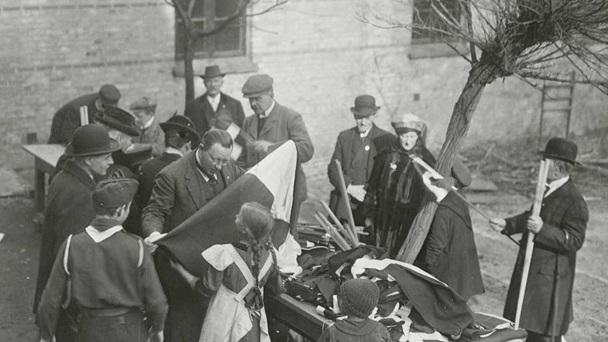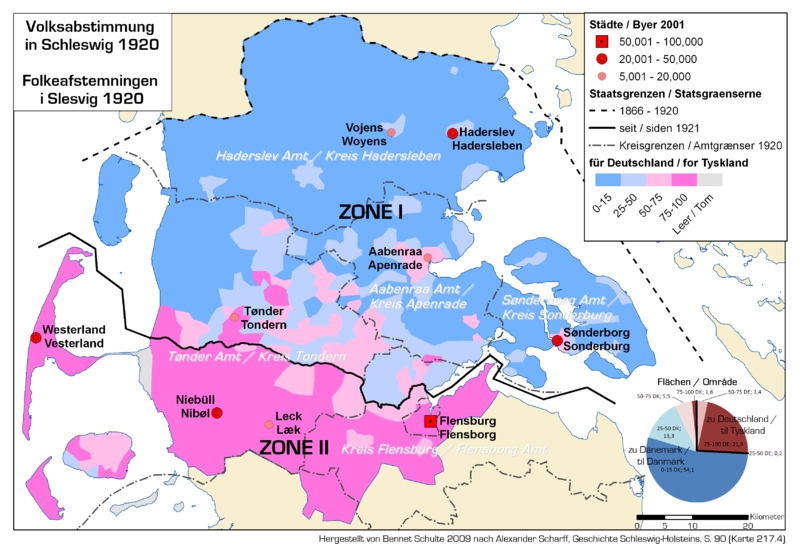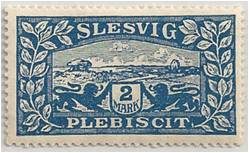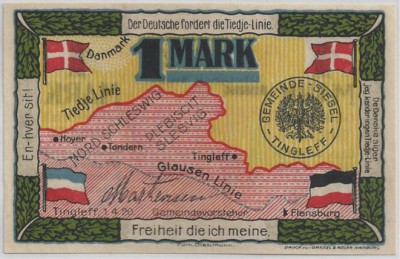ALBUM – view my Schleswig Album
Fast Facts
Region: Germany / Danish area
Group: Occupations and Plebiscites post wwI
Classification: Plebiscite
Prior Regime: The German Empire
Key Dates:
1919, Jun – Treaty of Versailles
1920, Feb 10 – Zone 1 plebiscite conducted
1920, Mar 14 – Zone 2 plebiscite conducted
1920, Jun 15 – North Schleswig officially becomes part of Denmark
Following Regime: Kingdom of Denmark (for North Schleswig)
Scott Catalogue: (Schleswig) #1-28, O1-14
Pick Catalogue: none, however many local notes (notgeld) were issued during the plebiscite era.
History

Schleswig is an area that borders Germany and Denmark, and for centuries was part of the Kingdom of Denmark, known as the Duchy of Schleswig. In 1864, the Kingdoms of Prussia and Austria conquered the Duchy of Schleswig, and jointly ruled the region until the Austro-Prussian war of 1866, where Prussia assumed sole possession of Schleswig. The Prussians joined Schleswig with the region just to the south, creating the provice of Schleswig-Holstein. The province continued when Prussia joined with other nations to become the German Empire in 1871.
At the end of World War 1, a plebiscite was called in the Schleswig region to determine the border between Germany and Denmark. The Schleswig plebiscite area was divided into two zones: Zone I, the northern and largest part of Schleswig, was populated by a majority of ethnic Danes, and Zone 2, in the middle of the region, consisted of about 80% Germans. There was a third zone to the south, but since the region was primarily populated by ethnic Germans, no vote was taken. The drawing of the border between the two zones caused considerable controversy and hot debate between Denmark and Germany, but ultimately a compromise was agreed based on population, and the results were a foregone conclusion.
The plebiscite for Zone 1 took place on 10 Feb, 1920, and as expected, the region overwhelmingly chose to become a part of the Kingdom of Denmark. In Zone 2, the vote was held on 14 Mar, 1920, and the region, also by a large margin, chose to remain with Germany.
North Schleswig (Zone 1) was transferred to Denmark on 15 June, 1920 and became Southern Jutland.

Stamps
 ALBUM
ALBUM
As with most plebiscite areas, postage stamps were issued in the region to “advertise” the event. In Schleswig, a set of 14 stamps were issued on 25 Jan, 1920, and was denominated in German currency, pfennig and marks. The pfennig stamps were smaller in size and depicted the coat of arms of Schleswig, while the top four stamps with denominations in marks were larger and depicted a Schleswig landscape.
Additionally, stamps overprinted “CIS”, standing for “Commission Interalliee Slesvig” were issued for official government use within Schleswig.
On May 20th, after the votes, Schleswig stamps were reissued in Zone 1 with new denominations in øre and kroner, the Danish currency, and were overprinted “1. ZONE”. These stamps were used until 30 June 1920, when they were replaced by Danish stamps.
Banknotes
 ALBUM
ALBUM
Although no “official” banknotes were issued in the region for the plebiscite, over 100 local notes (notgeld) were issued by the various communities in the region (on both sides).
Notgeld (or “emergency money”) was issued before and after the plebiscite, and in addition to serving as local currency, they were often printed with intersting propaganda notes for the plebiscite.
Links
Schleswig Plebiscites from Wikipedia
The re-unification of North Schleswig with Denmark in 1920 from Dansk Center for Byhistorie
Schleswig Plebiscite from Stamp Collecting World
Schleswig-Holstein Paper Money from Numismondo





Thank you, Michael, for your reply. I was very impressed, and rather pleased, to read your posting and offered my comments to provide a couple of routine corrections. You may be amused to know that although the Slesvig stamps lost their validity after 17 July 1920, they continued to be sold at the Danish philatelic agency until 30 September 1968. When I visited Copenhagen in September 1963 on my way back from Viet Nam, I was amazed to find them on sale. I subsequently found out the 1968 date from the chief of the Philatelic Department of the Danish Post & Tele Museum in Copenhagen.
I’m very glad you are doing this good work regarding Dead Countries. Best wishes.
Frank
Thank you for your kind words. Also, thanks for sharing an interesting additional story, I enjoy learning from others with experience and insight. Specializing in dead countries is more like a jack of all trades, but a master of none. But I do get to poke in all sorts of interesting areas, and am always glad when the experts come and add to the information.
Take Care
Michael
1. Slesvig Plebiscite stamps in Danish currency and overprinted “1. Zone” became available beginning on May 20, 1920, with seven denominations available and the remaining values issued later. Thus, complete sets on first day covers were postmarked later with backdated cancels.
2. These stamps were replaced by Danish stamps on 9 July 1920 (not 30 June) and were valid until July 17. Mixed frankings with Danish stamps were permitted.
3. German official stamps for Prussia (Scott #OL9-15, Michel Official#16-22) were authorized for use by local authorities in the plebiscite areas, such as courts, police and various other public entities, beginning in early April 1920, along with ordinary Slesvig stamps. Such bodies were not authorized to use the “C.I.S.” overprints.
4. Although Denmark assumed sovereignty over the First Zone after 16 June, the zone was not formally incorporated into the Kingdom of Denmark until 9 July, when King Christian X signed the necessary royal decree.
The above is taken from “The Schleswig Plebiscite of 1920,” which appeared inter alia in the September-October 2001 issue of German Postal Specialist and which contains very extensive notes and references regarding the philatelic history of this territory.
Hi Frank
Thank you for your thoughtful and detailed look at the article, you made me pull out my Michel to recheck at least the info I have. (that is a good thing)
I appreciate your expertise and insight, and will make appropriate changes and additions to my information.
Any other thoughts and corrections on my information in the German Area is of course most welcome.
Regards
Michael